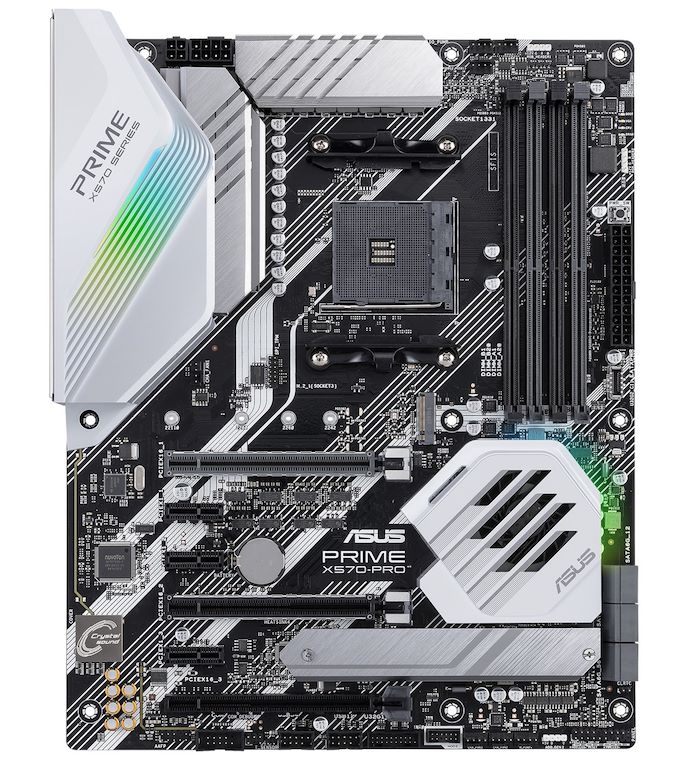The AMD X570 Motherboard Overview: Over 35+ Motherboards Analyzed
by Gavin Bonshor on July 9, 2019 8:00 AM ESTASUS Prime X570-Pro
Moving onto the ASUS Prime series of X570 motherboards, the ASUS Prime X570-Pro represents the more feature-laden of two ATX sized models; the other being the ASUS Prime X570-P. The ASUS Prime X570-Pro represents its less aggressive and non-gaming Prime range with a more subtle white and black aesthetic. The most notable aspects of the feature set include a Realtek S1220A HD audio codec, Gigabit NIC, and support for up to 128 GB of DDR4 memory.
The ASUS Prime X570-Pro offers three full-length PCIe 4.0 slots which run at x16, x8/x8, and x8/x8/x4. This allows for users to use two-way NVIDIA SLI and up to three-way AMD Crossfire multi-graphics card setups. Also present is three PCIe 4.0 x1 slots, with the board's storage capabilities coming through two PCIe 4.0 x4 M.2 slots, with the bottom slot coming with a heatsink; there are also six SATA ports with support for RAID 0, 1 and 10 arrays. In the top right-hand corner is four memory slots with support for up to 128 GB which allows users to install the 32 GB UDIMMs that has started making its way onto the market.
On the rear panel, the ASUS Prime X570-Pro includes three USB 3.1 G2 Type-A, one USB 3.1 G2 Type-C, and four USB 3.1 G1 Type-A ports. Adopters of AMD's impending Ryzen 3000 APUs and the Ryzen 2400/2200G will appreciate the HDMI and DisplayPort video outputs. There is also a PS/2 keyboard and mouse combo port, an Intel I211-AT Gigabit powered Ethernet port, and five 3.5 mm audio jacks and S/PDIF optical output driven by a Realtek S1220A HD audio codec.
The ASUS Prime X570-Pro has an MSRP of $250 and is more suited to users looking to avoid the swathe of gaming-themed models on the market. What the Prime series offers is elegant and neutral designs, which would actually look quite good with some RGB to make the white rear panel cover pop. There's support for two-way NVIDIA SLI and three-way AMD CrossFire too so users looking to build a more subtly styled gaming system can do so.












225 Comments
View All Comments
Mr Perfect - Tuesday, July 9, 2019 - link
Yeah, I'm having flashbacks over here. Weedy little fans screaming along at 6000RPM, then choking up on a dust bunny or wearing out the bearing.Do we know what process they used for the X570? Is it the same 55nm they used for the X470? Here's hoping they shrink it a little for X670.
DigitalFreak - Tuesday, July 9, 2019 - link
14nmerotomania - Tuesday, July 9, 2019 - link
55nmDanNeely - Wednesday, July 10, 2019 - link
no. X470 and below were 55nm (designed by ASMedia on an ancient process to keep everything cheap as dirt), X570 was done in house on 14nm. Ryzen 3's IO die is also 14nm (the much larger Epyc one was done at 12nm).erotomania - Wednesday, July 10, 2019 - link
Weedy, man! Those weedy fanssing_electric - Wednesday, July 10, 2019 - link
Given how little chipsets benefit from process shrinks, some part of me honestly wonders if there's any sense in going even further back to the future and dividing the chipset into a north/southbridge (or some other similar config) so that the heat can at least be spread out, getting rid of the need for a failure-prone mechanical part on your motherboard.YoloPascual - Tuesday, July 9, 2019 - link
z77 extreme 4 to x570 extreme 4 👊👊The_Assimilator - Wednesday, July 10, 2019 - link
I also owned a Z77 Extreme 4 at one time, and the X570 version is probably the closest to perfect that I've seen offered so far. If only it had a couple of extra USB ports on the back panel, it'd be a shoe-in.rUmX - Tuesday, July 9, 2019 - link
Hoping for price cuts on Intel cpus because no matter how good Ryzen is, these boards are way too expensive.Karmena - Tuesday, July 9, 2019 - link
Then get X470 or B450 boards. Or even X370 or B350 boards, you are in no way forced to use these latest mobos.